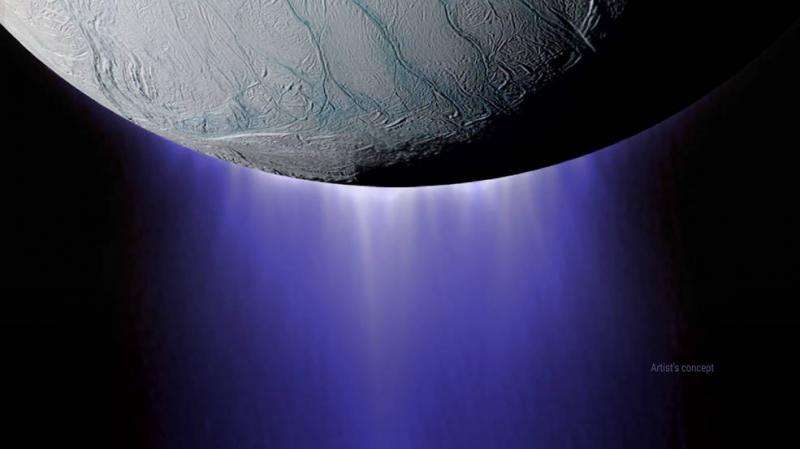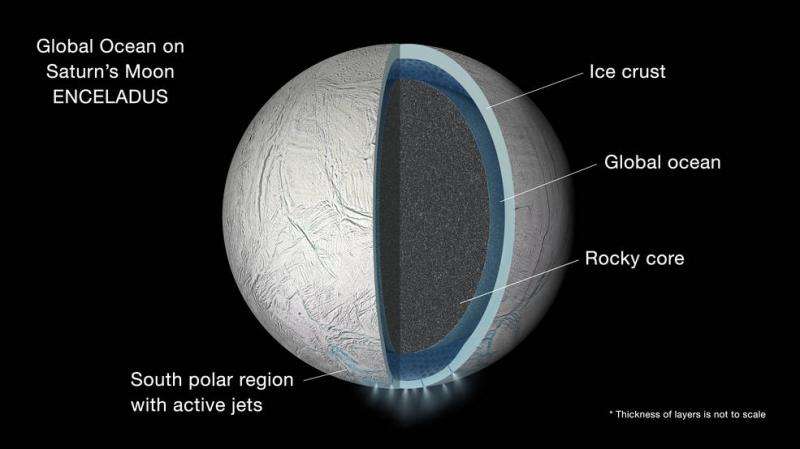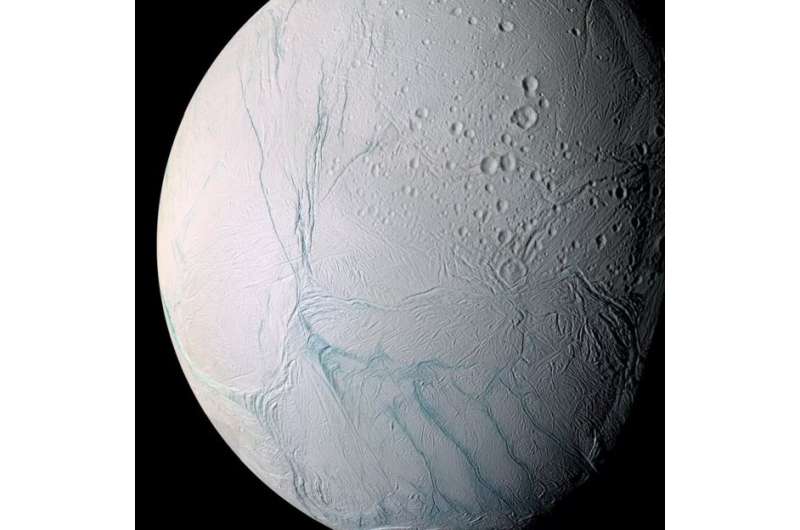Cassini plunged into icy plumes of Enceladus

The Cassini spacecraft took a daring plunge into the icy geysers of Saturn's moon Enceladus this week in search of telltale signs of a habitable environment.
The plume continuously jets thousands of miles into space from tiger stripe fissures in the moon's south pole, carrying particles from the vast salty ocean sloshing just beneath the icy surface.
Cassini's sweep though the icy fountain completes its second of three Enceladus flyby missions this year and is NASA's best shot at determining whether this small moon has the right ingredients to harbor life.
The encounter with the mysterious plume lasted only tens of seconds as Cassini hurtled past at a speed of about 19,000 miles per hour, yet in these critical moments up to 10,000 particles per second were sampled and identified using the probe's cosmic dust analyzer. Analysis of this data over the coming weeks could provide the most promising signs of habitability yet in the decade since Cassini's initial flyby of the moon in 2005.
"Cassini's instruments do not have the capability to detect life itself," Cassini project scientist Linda Spilker, told Astrobiology Magazine. "Those instruments can, however, make powerful measurements about the ocean and its potential habitability."
Earl Maize, Cassini's deputy program manager at NASA's Jet Propulsion Laboratory, further clarified the probe's abilities.

"Cassini has instruments that are capable of detecting complex organic molecules which could possibly be fragments of even larger molecules," he told Astrobiology Magazine, "However, the instruments are not capable of determining whether the processes are biological or geological."
NASA confirmed the existence of a global ocean sandwiched beneath Enceladus' icy crust and rocky core this year when scientists measured a slight gravitational wobble between the north and south pole, an unsteady movement that could only be accounted for by a hidden liquid layer. But what is keeping the underground water liquid and what is the driving force of these plumes? Today's flyby took us one step closer to that answer.
"There's some heat source that has caused a lot of that water-ice to melt and form liquid water," Curt Niebur, program scientist for the Cassini mission, told Astrobiology Magazine. "Our best guess and the most likely culprit is tidal heating from the interaction of Enceladus and the nearby moons and Saturn."
But there is one problem with that hypothesis: researchers' best calculations have shown that tidal heating does not generate as much heat as they are observing coming out of Enceladus. The exact nature of what drives the plumes is cause for much debate among the scientific community and its resolution is one of three main goals of this week's mission. The final two objectives relate directly to implications of habitability: whether hydrothermal activity is occurring on the sea floor and the chemical composition of organic particles, the building blocks of life.
Hydrothermal activity, much like the activity seen in Earth's deep-sea hydrothermal vents, is the chemical reaction between the rocky core and inner-ocean. This interaction creates energy necessary to sustain microbial life.
"I would be very excited to see a detection of a large amount of molecular hydrogen coming from the Enceladus plume," Spilker said. "This would indicate that a great deal of hydrothermal activity is occurring on Enceladus' seafloor, making it that much more likely that a habitat for life exists in Enceladus' ocean."

Using its neutral mass spectrometer, the probe sought out and identified the molecular hydrogen, if any. A lack of molecular hydrogen, however, does not necessarily rule out the possibility of hydrothermal activity.
Of Saturn's 62 moons, Titan, the largest, was once thought to hold the greatest promise of alien life, or at least a habitable environment. Enceladus has quickly vaulted to the top of that list, and the analysis of the data collected this week will help to confirm or refute that claim.
When asked which moon is most likely to harbor life, Maize replied, "Given the undersurface water ocean, hydrothermal activity, and presence of organic molecules, it seems that Enceladus would be the most likely. Titan also provides a lot of room for speculation, with its atmosphere and meteorological cycles that are very analogous to the Earth, but the chemistry would be quite different."
Even if molecular hydrogen and complex organics are confirmed in the coming weeks of intensive data analysis, Niebur cautioned against drawing quick conclusions.
"It's a huge step to go from that to even suggesting that you see signs of life. Detecting life is very nuanced and extremely difficult. Which is why, before investing an incredible amount of time, money and mission to do a life-detection, we answer a simple question —is it habitable? Is life even remotely possible? And that's fairly straightforward to assess. That's what Cassini can do."
Source: Astrobio.net
This story is republished courtesy of NASA's Astrobiology Magazine. Explore the Earth and beyond at www.astrobio.net .





















